I love the idea of growing my own food right in my urban kitchen.
With limited space, finding the right plants that thrive indoors can make a big difference.
Fast-growing edible plants not only provide fresh ingredients but also add a touch of greenery to my living space.
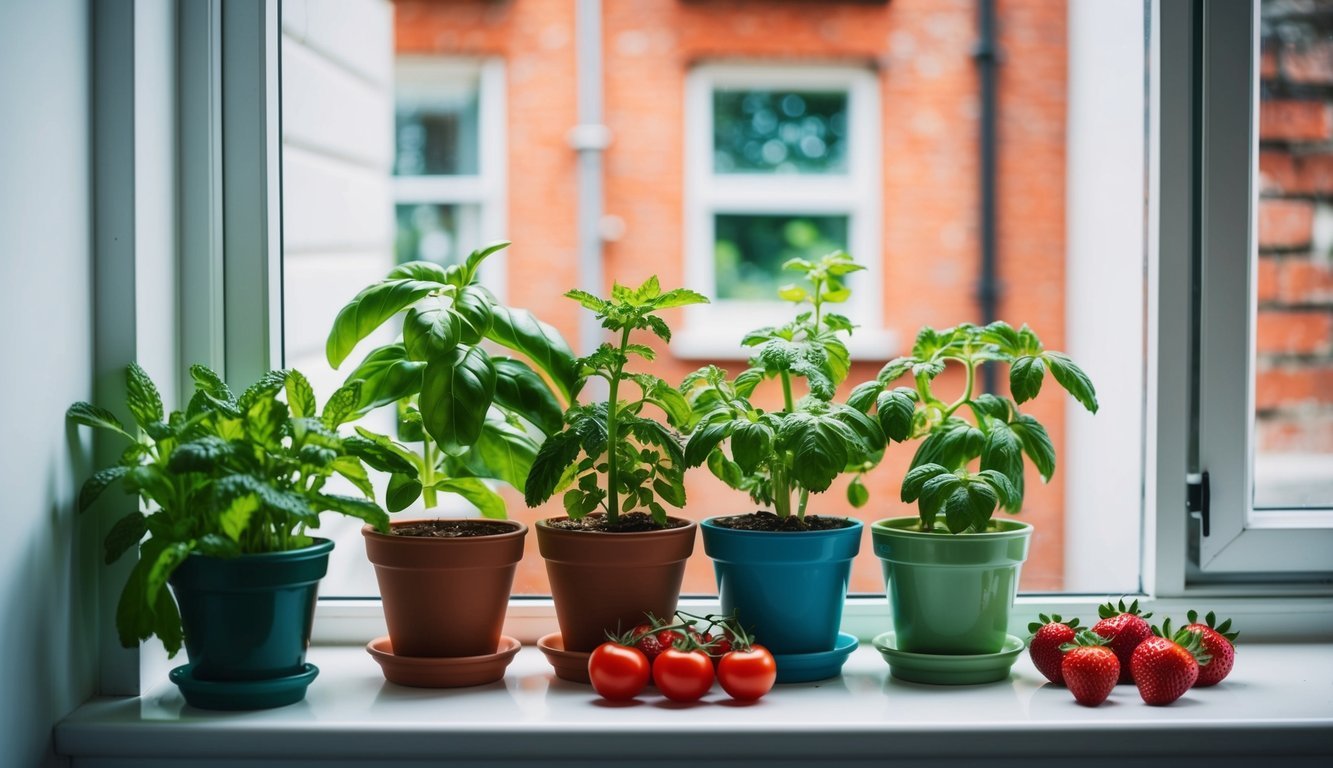
Choosing the right plants can be super rewarding, especially when I can harvest them in just a few weeks.
I’m excited to share some personal favorites that are perfect for urban settings, easy to care for, and delicious to eat.
Whether you have a sunny windowsill or just a bit of counter space, there’s a fast-growing edible plant that can fit into any kitchen.
1) Arugula
Arugula is one of my favorite fast-growing edible plants.
It matures in just 4 to 6 weeks, making it perfect for impatient gardeners like me.
Plus, it adds a peppery kick to salads and other dishes.
I plant the seeds about a quarter-inch deep, spacing them 1 inch apart.
Rows ideally should be 10 inches apart to let them spread out.
A sunny spot works best, but they also thrive in partial shade.
To give my arugula the best start, I mix in some aged garden compost before planting.
This helps improve soil quality and provides essential nutrients.
If the weather heats up, I provide a little afternoon shade to keep them happy.
I love that I can keep planting new seeds every two to three weeks for a continuous harvest.
If I sow them more densely, I can thin them out and enjoy those young leaves in my meals.
Arugula not only grows quickly but also brings a fresh taste to my kitchen.
Microgreens
I love growing microgreens because they’re quick and easy to cultivate in small spaces.
Some of the fastest varieties, like radish and mustard, can be ready to harvest in just 5 to 14 days.
These tiny greens pack a punch in flavor and nutrition.
They can liven up any dish with their vibrant colors and fresh taste.
Other great options include arugula, broccoli, and turnips, which also grow rapidly.
One of my favorites is corn shoots.
These sweet, earthy greens are typically ready in 6 to 8 days.
They add a unique touch to salads and sandwiches.
With over 1,500 types of microgreens out there, I enjoy experimenting with both common and lesser-known varieties.
Each type offers different flavors and nutritional benefits, making it fun to discover new tastes.
Growing microgreens is a simple way to enhance my meals while enjoying the process of gardening.
Even in small apartments, they thrive indoors near a sunny window or under grow lights.
3) Radishes
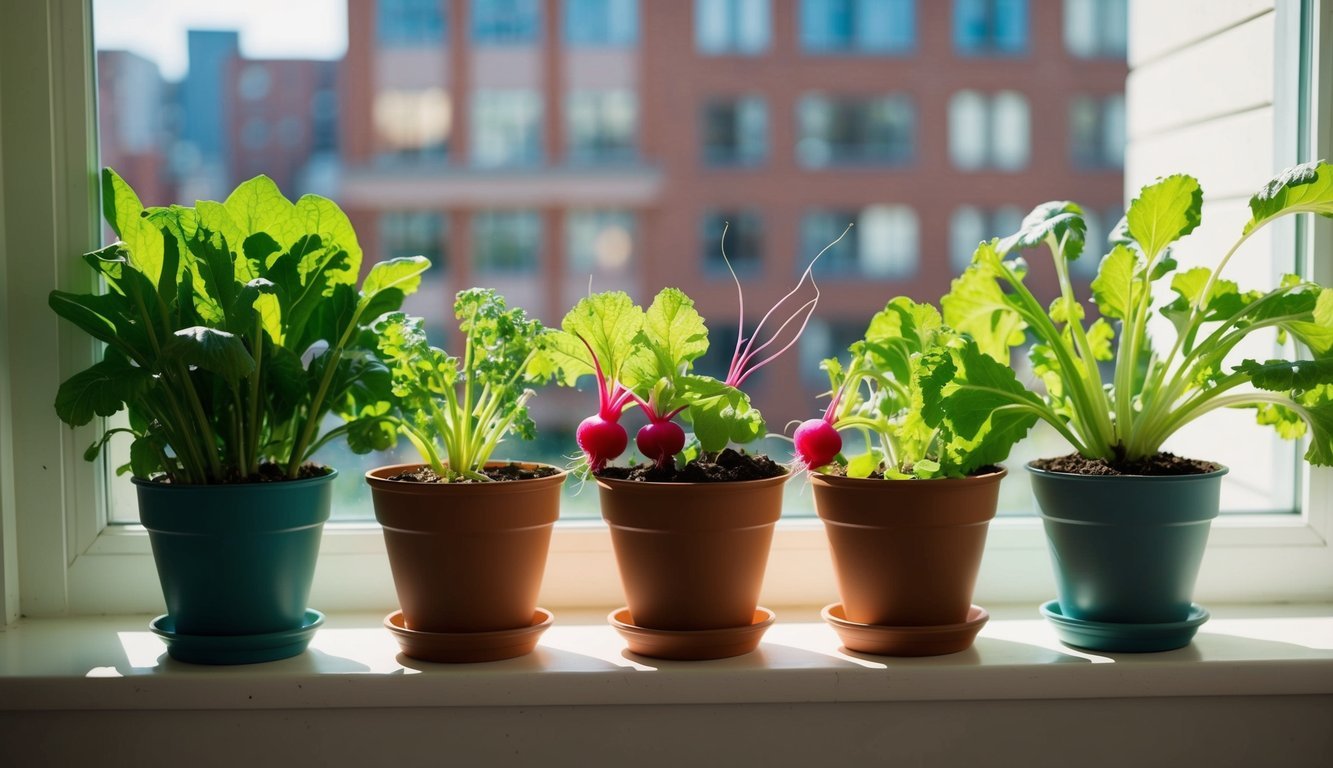
I love growing radishes because they’re so quick and easy to care for.
These little veggies can go from seed to harvest in about three to four weeks, making them perfect for my urban kitchen garden.
With just a bit of sunlight and good soil, I can have fresh radishes ready to munch on.
They thrive in containers, so even if I’m limited on space, I can use shallow storage totes or window boxes.
It’s important to give them a sunny spot; they need about six hours of sunlight daily.
I usually plant them in clusters to maximize my space and combat pests with companion planting.
Pairing radishes with plants like spring onions or garlic helps deter critters that like to nibble on my crops.
Plus, they look great together in the garden!
When harvesting, I simply pull them out once they reach the desired size.
The crunch and peppery flavor add a fresh touch to salads and sandwiches.
Growing radishes has become one of my favorite gardening experiences.
4) Chives
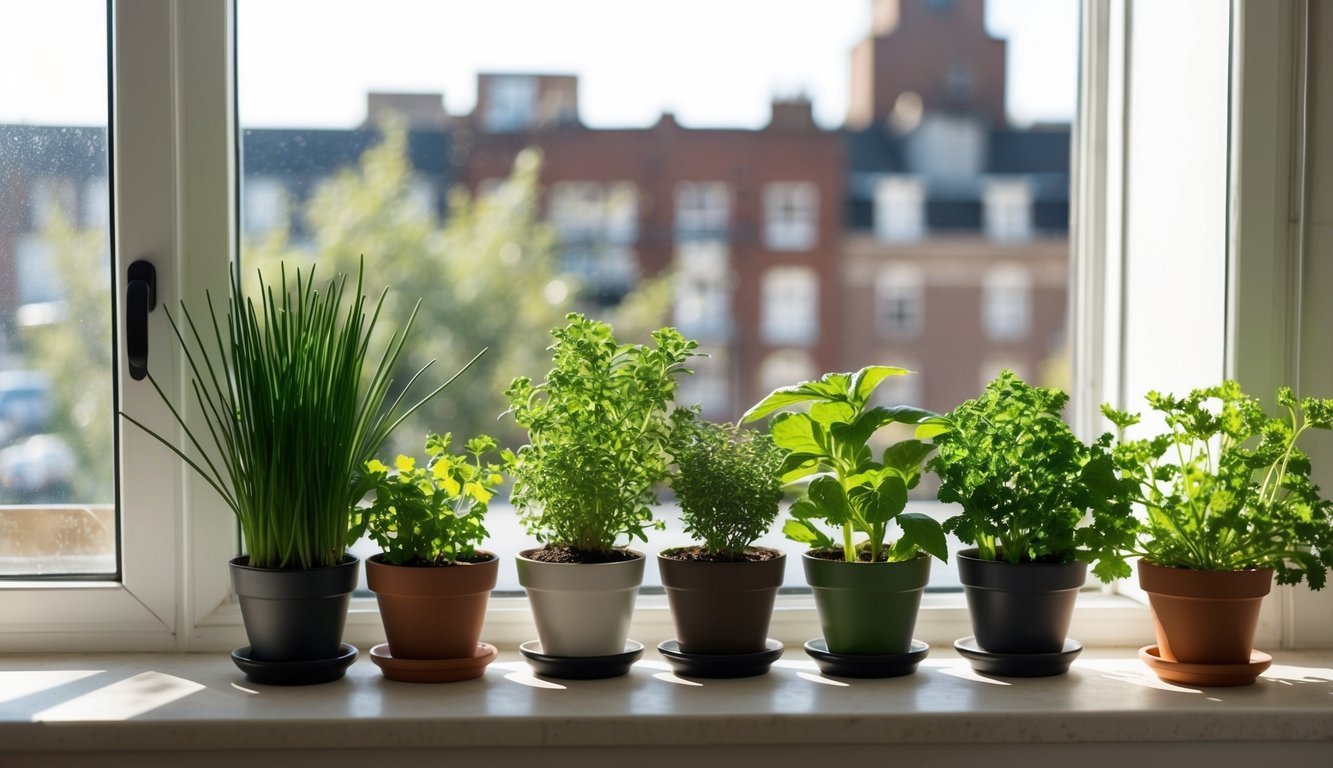
Chives are one of my favorite herbs to grow in my urban kitchen.
They’re easy to care for and add a fresh, mild onion flavor to many dishes.
I love that common chives are widely available and can thrive in small pots.
They grow in clumps, and I usually space them about 6 inches apart.
This gives them plenty of room to flourish.
When planting chives, I start by sowing the seeds about 1/8 inch deep.
After sowing, I gently water them to keep the soil moist.
Patience is key, but the wait is worth it.
If I want quicker results, I sometimes pick up young chive plants from a garden center.
I can just pop them into pots in the spring, and they take off.
What’s great is that chives need around 6-8 hours of sunlight a day.
If my kitchen doesn’t get enough natural light, I use fluorescent bulbs to give them a boost.
With minimal effort, I can enjoy my homegrown chives, adding a punch of flavor to salads, soups, and more.
5) Basil
Basil is one of my favorite herbs to grow in the urban kitchen.
It thrives in small spaces and can be planted in pots or containers, making it perfect for balconies or windowsills.
I love sweet basil for its aromatic flavor.
It adds a fresh touch to salads, pasta, and even pizzas.
Plus, the leaves are easy to snip off whenever I need them.
There are many varieties to explore.
Lemon basil has a refreshing citrus aroma, which is great for teas or desserts.
Cinnamon basil brings a warm spice, perfect for herbal infusions.
Planting basil is simple.
It grows quickly and can reach about 2 feet tall, providing plenty of leaves to harvest.
Just make sure it gets enough sunlight and well-drained soil.
I find that regular watering helps keep the plants healthy.
If you regularly pinch back the growth, it encourages bushier plants and a better yield.
Basil is versatile and a must-have in any urban garden.
Benefits of Growing Edible Plants
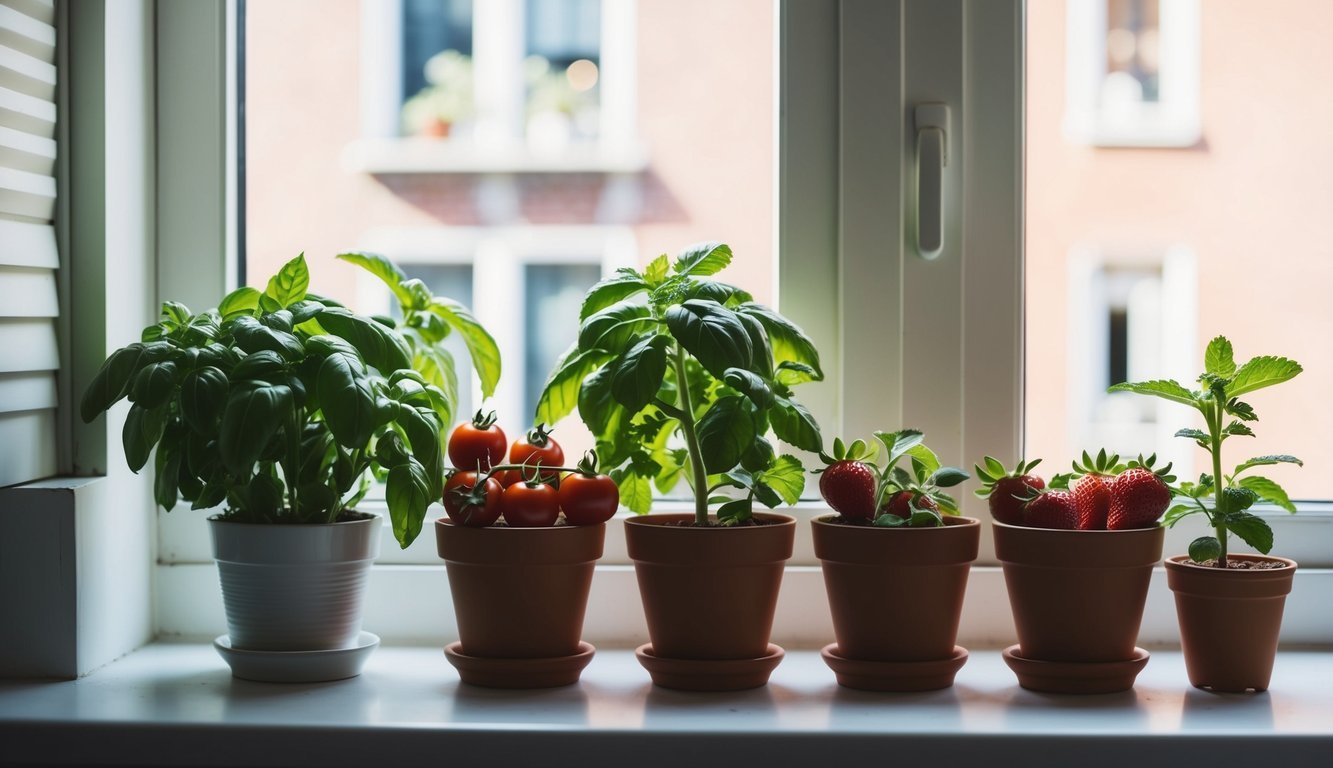
Growing edible plants in my urban kitchen has given me a host of benefits that extend beyond just having fresh ingredients at my fingertips.
These plants not only contribute positively to my health but also make a difference in the environment around me.
Health Advantages
When I grow my own edible plants, I’m ensuring that I’m consuming fresh and nutritious food.
Homegrown veggies and herbs often have higher nutrient levels than store-bought options.
Plus, they don’t contain any harmful pesticides or preservatives.
Diverse homegrown produce like leafy greens, tomatoes, and herbs can enhance my diet.
Fresh ingredients are known to boost my immunity, improve digestion, and contribute to overall well-being.
I also enjoy knowing exactly what goes into my meals, making it easier to eat healthily and avoid processed foods.
Environmental Impact
Cultivating my own edible plants has a positive ripple effect on the environment.
It reduces my carbon footprint since I’m not relying on transportation for grocery shopping.
Additionally, home gardening supports biodiversity.
I can attract beneficial insects and pollinators by planting a variety of species.
This diversity contributes to a healthier ecosystem right in my backyard.
By growing my own plants, I also reduce waste associated with packaged foods.
It’s a small step, but every little bit helps in supporting sustainable practices.
Tips for Urban Gardening
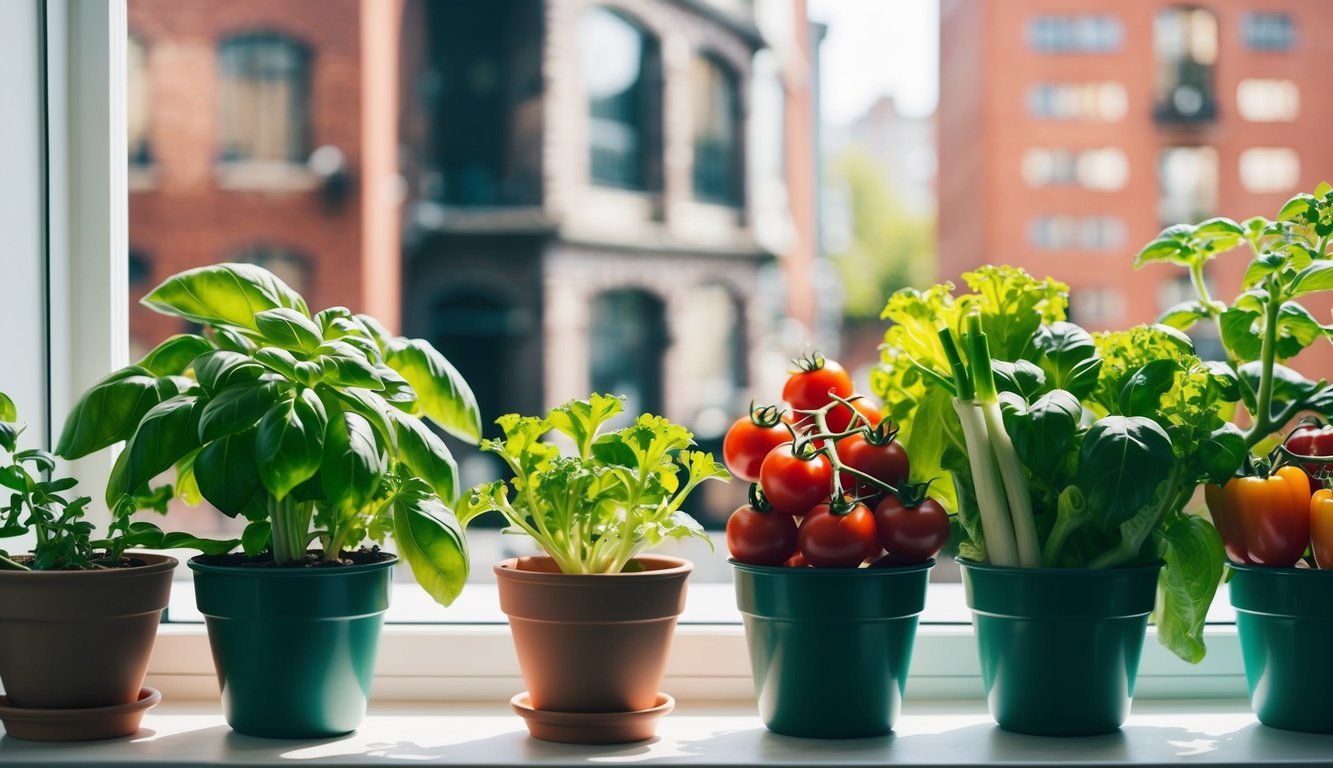
Urban gardening can be immensely rewarding, and with some practical tips, I can make the most out of my limited space and resources.
Focusing on how to optimize my available area and selecting the right soil and fertilizers can really elevate my urban gardening experience.
Space Optimization
Maximizing space is essential in an urban environment.
I use vertical gardening techniques to create more room for my plants.
Trellises or wall-mounted planters can turn empty walls into thriving green spaces.
Another great option is container gardening.
I can choose various sizes that fit different spaces, whether it’s a balcony, windowsill, or small patio.
I also try to group plants with similar needs together.
This approach not only saves space but also helps me manage watering and light requirements more efficiently.
Herb gardens are perfect for this since they usually thrive together while providing fresh ingredients for my meals.
Soil and Fertilizer Selection
The foundation of a successful urban garden lies in soil quality.
I make sure to start with well-draining soil enriched with compost for nutrients.
Compost adds both benefits, improving soil structure and providing essential nutrients.
It’s also helpful to test my soil’s pH and nutrient levels.
I look for amendments like bone meal or fish emulsion for phosphorus and nitrogen if needed.
For ongoing care, I opt for organic fertilizers that are less harsh on a small garden’s ecosystem.
Using slow-release fertilizers ensures my plants get the nutrients they need over time without the risk of over-fertilization.
Regularly refreshing the compost or even adding homemade compost from kitchen scraps boosts soil health and plant growth.
Maintaining Your Urban Garden
Keeping an urban garden thriving requires a bit of care and attention.
I find that the right watering techniques and effective pest control methods make a big difference in the health of my plants.
Watering Techniques
Watering is crucial for urban gardens, especially in containers or small spaces where soil can dry out quickly.
I prefer deep, infrequent watering to encourage root growth.
It’s best to water in the early morning or late evening to reduce evaporation.
I recommend using a drip irrigation system if possible.
This setup delivers water directly to the roots, making it efficient.
For hand watering, I use a watering can with a long spout to reach hard-to-access plants.
Tips for watering:
- Check the soil moisture with your finger; go an inch deep.
- Mulch around plants to retain moisture and reduce weeds.
- Adjust according to the season; plants may need more water in hot weather.
Pest Control Methods
Managing pests in an urban garden is vital to keeping plants healthy.
Prevention is the first step.
I encourage beneficial insects like ladybugs and lacewings, which feast on pests.
If I notice unwanted visitors, I use natural solutions first.
A simple spray of water can dislodge pests like aphids.
For more persistent issues, I might use a mix of insecticidal soap or neem oil.
Pest control strategies:
- Introduce companion planting; some plants can repel harmful insects.
- Keep an eye on plants regularly for any signs of trouble.
- Discard heavily infested plants to prevent spread.
By staying on top of these maintenance tasks, I can enjoy a thriving urban garden full of fresh produce.

